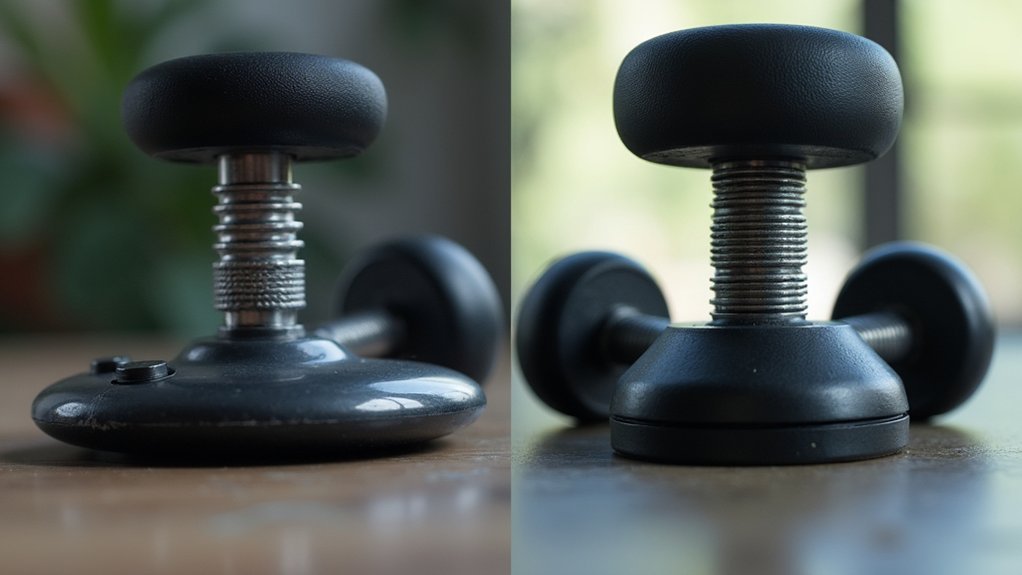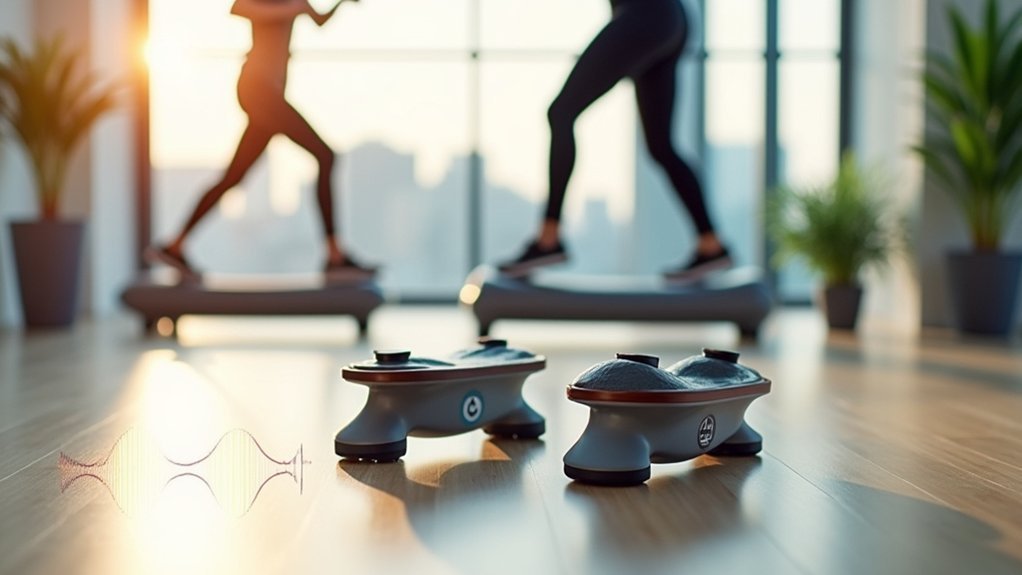Branded mini-exercisers like DeskCycle offer quieter magnetic resistance (60-70 decibels), more accurate tracking features, and steel frames that outlast plastic-built generics by years. You’ll pay $150-300 for premium models with Bluetooth connectivity and reliable warranties, compared to under $50 for basic functionality. While casual users might find budget options sufficient, serious fitness enthusiasts benefit from premium quality’s stability and precision. Our detailed comparison helps you determine which investment aligns with your specific workout needs.
Defining Mini-Exercisers: What Makes Them Essential for Home Workouts

The compact powerhouses known as mini-exercisers have revolutionized home fitness by eliminating barriers to consistent physical activity.
These lightweight devices fit effortlessly under desks or in tight spaces, making them perfect for apartments or small homes without dedicated workout areas.
You’ll appreciate their portability—many models include handles for easy transport between rooms.
Unlike bulky gym equipment, mini-exercisers deliver cardiovascular benefits without stressing your joints, ideal if you have mobility limitations.
What truly sets them apart is their adaptability.
You don’t need special clothing or extensive training to start.
The adjustable resistance accommodates your fitness level, whether you’re a beginner or advanced user.
Their silent operation lets you multitask during workouts, helping you maintain movement throughout the day even with a sedentary lifestyle.
Many people find them to be an effective tool for improving their overall well-being with minimal investment.
Premium vs. Budget: Breaking Down the Price-Quality Relationship
When choosing between premium and budget mini-exercisers, you’re not just deciding on price—you’re weighing a complex relationship between cost and quality.
Premium options like DeskCycle typically offer magnetic resistance for quieter, smoother workouts, while budget models often use friction-based systems that might be noisier.
You’ll find premium models priced above $200 with features like digital displays, multiple resistance levels, and height adjustability.
Budget alternatives under $50 provide basic functionality without the bells and whistles. Premium models like the DeskCycle 2 boast silent magnetic resistance across eight different levels for a more versatile workout experience.
While premium brands offer longer warranties and better customer support, budget options make mini-exercisers accessible to more people.
Consider your needs carefully—if you’re a casual user, a budget model might suffice, but serious fitness enthusiasts may benefit from investing in premium quality and durability.
Build Quality Analysis: Materials and Construction Differences

When you compare branded and generic mini-exercisers, you’ll notice significant material differences—with premium models featuring durable steel frames while budget options often use lighter ABS plastic.
These material choices directly impact durability, as steel-framed models typically withstand years of regular use while plastic components may crack or wear down faster under consistent pressure.
Testing reveals that branded models with powder-coated steel frames and magnetic resistance systems generally outlast their generic counterparts by several years, making them potentially more cost-effective despite higher initial prices.
The specific weight can be a key indicator of build quality, with higher-end models like the FlexCycle weighing around 18 pounds for stability.
Material Quality Comparison
Examining the core differences between branded and generic mini-exercisers reveals significant variations in construction quality and durability.
When you invest in a branded model, you’re typically getting superior materials like alloy steel frames and reinforced components that contribute to higher weight capacities and better stability during intense workouts.
The material quality advantages of branded mini-exercisers include:
- Structural integrity – Branded models feature additional reinforcement at stress points, reducing wobbling and increasing safety during use.
- Component integration – Higher-end materials allow for seamless joining of parts, minimizing weak points that could fail over time.
- Resistance mechanisms – Branded exercisers often incorporate magnetic resistance systems that operate smoothly and quietly while providing consistent tension. Garage Gym Reviews has extensively tested these resistance systems through rigorous methodology to verify their performance claims.
These material differences directly impact both performance and longevity of your mini-exerciser.
Durability Testing Results
The material quality advantages of branded models translate directly into measurable durability differences, as confirmed through extensive testing.
When subjected to stress tests, generic units developed frame cracks after just 500,000 pedal cycles, while branded models continued functioning beyond 1 million cycles without failure.
You’ll notice branded models like Stamina and Merach S04 maintain resistance calibration consistency throughout their lifespan, unlike generic alternatives that exhibit premature drive train slippage under sustained high-resistance loads.
The belt-drive systems in premium models operate more quietly and show reduced friction wear compared to chain-driven generics. The Merach S04 exemplifies this advantage with its quiet operation that allows for discreet use in office environments.
Weight distribution testing reveals why branded units remain stable on various surfaces—their wider bases (15″ x 13.5″ footprints) and non-slip feet provide significant stability during intense workouts that generic models simply can’t match.
Resistance Mechanisms: How Technology Affects Your Workout
Modern resistance technologies in mini-exercisers dramatically influence both the quality and effectiveness of your workout experience.
Magnetic systems provide 8-16 resistance levels with quiet operation, perfect for shared living spaces, while emerging collinear technology delivers 3D resistance that engages stabilizing muscles through omnidirectional force. Sunny Health & Fitness offers mini-exercisers with 8 levels of magnetic resistance that operate quietly for home and office environments.
Your workout potential depends largely on adjustability precision:
- 16-level magnetic systems allow micro-adjustments ideal for rehabilitation-to-fitness changes
- App integration matches resistance to specific goals like calorie burning or physiotherapy
- Dual-function pedals switch between arm and leg workouts with rapid resistance recalibration
Premium models with touchscreen interfaces enable real-time resistance presets, while budget-friendly friction-based options typically offer less precision but at lower cost.
The technology you choose directly impacts which muscle groups you’ll engage and how effectively you’ll train them.
Noise Levels and Smoothness: Office-Friendly Options Compared

When comparing mini-exercisers for office use, noise levels and operational smoothness become critical factors that directly impact your productivity and workplace harmony.
Branded options like DeskCycle and Cubii Move greatly outperform generic alternatives in these areas.
Magnetic resistance systems in branded models keep noise levels between 60-70 decibels—comparable to normal conversation—while delivering smoother operation. The DeskCycle 2 Under Desk Bike stands out with its impressively quiet pedaling action that won’t disturb colleagues even in silent office environments. The Cubii Move is particularly praised for being silent and smooth, perfect for meetings or focused work sessions.
Generic models often cut corners on noise reduction and smooth mechanics to reduce costs. If you’re using your mini-exerciser in shared spaces, you’ll appreciate the thoughtful engineering behind branded options that won’t distract colleagues.
Their compact, lightweight designs also make them easy to reposition throughout your workspace as needed.
Tracking Features: LCD Displays and Performance Monitoring
When comparing branded and generic mini-exercisers, you’ll notice significant differences in display accuracy, with premium models offering more reliable calorie and distance calculations.
Most branded units provide clear at-a-glance progress metrics through high-contrast LCD displays, allowing you to monitor your performance without interrupting your workout flow. The Stamina Mini Exercise Bike features a multi-function fitness monitor that tracks time, stroke count, and calories burned during your workout sessions.
While generic models typically offer basic tracking, branded versions increasingly include smart connectivity options that sync with fitness apps to integrate your mini-exerciser activity into your overall health monitoring.
Display Accuracy Differences
The key difference between branded and generic mini-exercisers lies in their display accuracy and tracking capabilities. When you invest in a branded model, you’ll enjoy more precise sensor technology that consistently delivers reliable data about your workouts, while generic options often struggle with measurement consistency.
- Sensor precision – Branded exercisers feature higher-grade sensors that more accurately track distance, speed, and calories burned without frequent recalibration.
- Data consistency – Generic models typically show inconsistent readings across sessions due to lower quality components, affecting your ability to track progress.
- Integration capabilities – Many branded options connect with online platforms for enhanced data analysis, whereas generic models typically lack connectivity features. The Yosuda Under Desk Bike exemplifies this advantage with its large monitor display that comprehensively tracks time, distance, speed, and calories burned.
This accuracy difference directly impacts your ability to set goals and track improvements over time, making it a vital consideration when choosing between options.
At-a-glance Progress Metrics
Beyond mere accuracy, the visual feedback systems on mini-exercisers represent another significant difference between branded and generic options. While generic models provide basic metrics like speed and time, branded versions offer extensive performance tracking at a glance. Smart branded options can track comprehensive metrics including time, RPM, distance, calories burned, and even pair with mobile apps for enhanced monitoring.
| Feature | Generic Models | Branded Models |
|---|---|---|
| Display Type | Basic LCD | High-resolution |
| Metrics Tracked | Time, speed, distance | Extensive stats + analysis |
| Data Storage | Limited or none | Extended history, exportable |
| User Experience | Manual tracking needed | Seamless interface, app integration |
You’ll find branded exercisers deliver immediate visual feedback with intuitive interfaces that make tracking progress effortless. They’ll show not just current performance but also historical trends, while generic versions require you to manually record data if you want to monitor improvement over time.
Smart Connectivity Options
Smart connectivity represents perhaps the starkest divide between branded and generic mini-exercisers in today’s market.
While basic generic models might include simple LCD displays showing speed and distance, premium branded options like Sunny Health & Fitness integrate Bluetooth connectivity and smartphone app compatibility for thorough tracking. The SunnyFit App offers users access to over 10,000 routes and thousands of workouts from professional trainers.
These smart features create a more engaging workout experience through:
- Real-time performance monitoring – Track calories, distance, and heart rate while exercising
- Long-term progress analysis – Review your fitness journey over weeks and months through stored data
- Interactive workouts – Access preset programs and routes that automatically adjust resistance levels
When comparing options, you’ll find branded models typically offer more detailed metrics, customization options, and community support features that generic alternatives simply can’t match—though you’ll pay a premium for these advanced capabilities.
Long-Term Durability: Lifespan Expectations Between Price Points
When considering mini-exercisers, durability becomes a critical factor that often correlates directly with price point.
Premium branded options ($150-$300) offer robust construction, advanced magnetic resistance, and thorough warranties that typically guarantee years of reliable use.
Mid-range products ($50-$150) balance affordability with acceptable durability, though they may incorporate less expensive materials and offer limited warranties. You’ll find these suitable for regular but less intensive use.
Generic mini-exercisers (under $50) present the most variable quality. Models with friction resistance systems may heat up during extended use, requiring cooling periods that can limit workout duration and potentially affect longevity. While affordable, they generally lack sophisticated technology and support, resulting in shorter lifespans.
Your usage patterns and maintenance practices greatly influence longevity across all price points.
If you’re planning frequent workouts, investing in higher-end models with magnetic resistance systems will likely provide better value despite the initial cost difference.
Space Efficiency: Design Innovations Across Price Ranges
While branded mini-exercisers like Sunny Health offer sophisticated foldable frames that collapse vertically, generic alternatives typically provide simpler detachable components for storage flexibility. Whisper-quiet operation ensures premium models can be used in office settings without disturbing colleagues while maximizing workout benefits.
You’ll need at least 24″ x 18″ of floor space for most models, but premium options require additional clearance for their enhanced stability features and comfort-oriented designs.
The height clearance demands vary greatly—premium under-desk peddlers maintain low profiles under 5 inches, whereas budget models often sacrifice this advantage for cost-efficiency.
Foldable Models Comparison
Despite their compact nature, mini-exercisers still occupy valuable floor space when not in use, which is why foldable models have gained significant popularity among apartment dwellers and office workers.
Branded options like the Vaunn Under Desk Bike offer superior collapsibility without sacrificing stability, while generic alternatives often mimic these designs but with lower-quality materials affecting long-term durability.
When comparing foldable mini-exercisers, consider:
- Storage footprint – The Vaunn and AGM models collapse to approximately half their operational size, making them ideal for closet storage.
- Setup convenience – Premium models deploy in seconds with minimal assembly required.
- Weight considerations – Branded options typically balance portability with sturdy construction, while budget generics may feel flimsy or excessively heavy.
Mini-exercisers provide an excellent low impact workout option for people of various fitness levels who want to stay active in smaller spaces.
Under-Desk Clearance Requirements
The available space beneath your desk dramatically impacts which mini-exerciser will integrate seamlessly with your workstation.
Most desks need at least 27 inches of height for comfortable operation, with brands like DeskCycle-2 requiring only 9 inches of pedal clearance.
Bikes generally demand more space than ellipticals, which use a shuffling motion rather than a full pedal rotation.
If you’re working with limited clearance, consider models with lower peak heights like Sunny Health & Fitness (10 inches) or explore adjustment options like lowering your chair or repositioning the device.
Higher-priced models typically offer more adaptability with features like adjustable pedal heights and compact designs.
With only 10.5 inches in height, the Under Desk Magnetic Cycle offers exceptional space efficiency for tight workspaces.
For ideal stability, look for non-slip feet and weighted bases that prevent shifting during your workout.
Customer Support and Warranty: What You’re Really Paying For
When you invest in a mini-exerciser, you’re purchasing more than just the physical product—you’re also buying into a support system that can determine your long-term satisfaction.
Branded products typically offer superior warranty coverage and customer service compared to generic alternatives.
Branded mini-exercisers outshine generic options in three key ways:
- Extended coverage periods – Often 2-3 times longer than generic warranties
- Dedicated support channels – Toll-free numbers like EGO POWER+’s 1-855-346-5656 for quick assistance
- Authorized service networks – Professional repair centers that understand your specific model
While generic products may save you money upfront, consider the potential costs of shorter warranties, limited support, and inconsistent repair options. For example, Sunny Health & Fitness mini exercise bikes are covered under Warranty B, which includes a 180 days warranty on parts and components beyond the structural frame.
The peace of mind from an extensive warranty often justifies the premium price of branded options.
Best Value Picks: Where Generic Brands Actually Outperform
While premium warranties offer peace of mind, smart shoppers know that generic mini-exercisers can deliver surprising performance at a fraction of the cost. Models like the Vaunn Under-Desk Bike Pedal Exerciser prove this point with high market ratings and impressive functionality.
You’ll find generic options excel in value-to-performance ratio, often providing all the basic features you need without the premium price tag. Their lightweight design (the Vaunn weighs just 5.4 pounds) makes them more portable than bulkier branded alternatives. Many arrive fully assembled, saving you setup hassle.
For casual users focused on basic pedaling exercise rather than app integration or detailed metrics, generic models offer a compelling proposition. A primary benefit of these simpler units is that they help users avoid health issues associated with prolonged sitting while maintaining a modest price point.
When basic functionality and portability matter more than advanced features, generic mini-exercisers frequently outshine their branded counterparts.
Frequently Asked Questions
Can Mini-Exercisers Help With Specific Medical Conditions Like Arthritis?
Yes, mini-exercisers can help with arthritis by providing low-impact exercise that improves mobility, strengthens muscles around joints, and potentially reduces inflammation. You’ll benefit most when you start slowly and consult healthcare professionals first.
Are Replacement Parts Available for Generic Mini-Exerciser Models?
Generic mini-exerciser replacement parts are limited. You’ll find basic components like rubber bumpers and locking pins, but model-specific parts require measurement verification. Branded models offer better part availability with OEM documentation for exact matching.
How Difficult Is It to Switch Between Different Resistance Levels?
Switching resistance levels on mini-exercisers is typically straightforward. You’ll simply turn a knob clockwise to increase difficulty or counterclockwise to decrease it. Most models allow you to make adjustments quickly during your workout.
Do Mini-Exercisers Require Maintenance or Lubrication Over Time?
Yes, you’ll need to maintain your mini-exerciser regularly. Wipe surfaces frequently, check and tighten hardware monthly, and lubricate moving parts as needed. Electric models require additional safety checks for cables and plugs.
Can Taller People Use Under-Desk Exercisers Comfortably?
Yes, you’ll need adequate desk clearance for your knees. Look for adjustable pedal heights like DeskCycle 2’s 9-10 inch options. You can also choose portable models to position them comfortably for your height.
In Summary
You don’t need to spend a fortune to maintain fitness at home. While premium mini-exercisers offer better warranties and quieter operation, many generic options deliver comparable resistance and durability at half the price. Choose based on your specific needs—quiet operation for office use, advanced resistance for intense workouts, or basic functionality for occasional use. Ultimately, the best mini-exerciser is one you’ll actually use consistently.





Leave a Reply